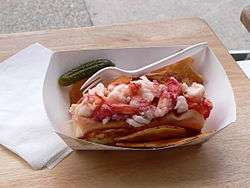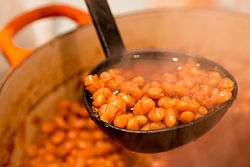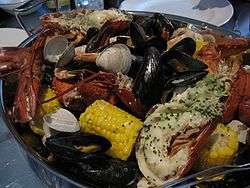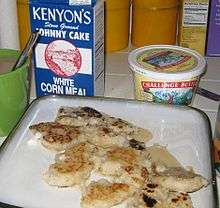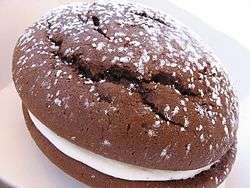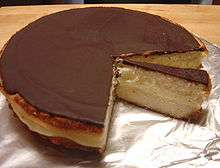Cuisine of New England
| Part of a series on |
| American cuisine |
|---|
|
Regional cuisines
|
|
Ingredients and foods |
|
Ethnic and cultural |
|
Holidays and festivals |
|

New England cuisine is an American cuisine which originated in the New England region of the United States. It is characterized by extensive use of seafood and dairy products, which results from its historical reliance on its seaports and fishing industry, as well as extensive dairy farming in inland regions. Many of New England's earliest Puritan settlers were from eastern England, where baking foods was more common than frying, such as pies, beans, and turkey, as was the tradition elsewhere.[1] Two prominent characteristic foodstuffs native to New England are maple syrup and cranberries. The traditional standard starch is potato, though rice has a somewhat increased popularity in modern cooking. New England cuisine is known for limited use of spices aside from ground black pepper, although parsley and sage are common, with a few Caribbean additions such as nutmeg. Use of cream is common, due to the reliance on dairy. The favored cooking techniques are stewing, steaming, and baking.
History

Native American foods and cooking methods were adopted by early immigrants to New England, such as corn meal johnny cakes, oysters, succotash, and New England clam bakes, as were many staples of their diet, such as the nuts of the black walnut tree, the nuts of the shagbark hickory, popcorn, blueberries, blackberries, and beach plums. In England during this period, carrying weapons (especially guns) was forbidden to any but the upper classes. Upon reaching the New World, these Englishmen found themselves in a land where they could feast on venison from the white tailed deer and the Eastern moose and shoot pigeons for their meat, some of which were likely featured at the first Thanksgiving feast in 1621.[2]
Many of New England's earliest Puritan settlers were from eastern England and also brought with them traditions of dairy products and baking pies and other foods. Baked beans, apple pies, baked or roast turkey, pease porridge, and steamed puddings became common Yankee dishes; some are now common nationally during Thanksgiving dinners.[1] Other foods which they would have prized included roast duck and roast goose, lamb, and hams, and all of these were brought to the New World as farmyard stock as soon as the colonies began to prosper.
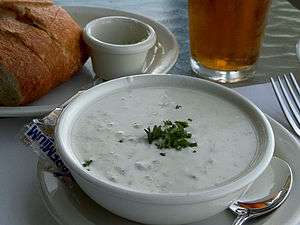
Molasses and rum were common in New England cuisine, due to New England's involvement in the Triangle Trade in the 18th century.[3] Molasses from the Caribbean and honey were staple sweeteners for all but the upper class well into the 19th century.[4] Some of the finest rum distilleries were located in New England prior to Prohibition.[4]
Many herbs were uncommon, particularly Mediterranean herbs, which are not hardy in much of New England away from the coast. As a result, most savory New England dishes do not have much strong seasoning, aside from salt and ground black pepper, nor are there many particularly spicy staple items.[4] Other dishes meant as desserts often contain ingredients such as nutmeg, cinnamon, allspice, cloves, and ground ginger which are a legacy of trade with the Caribbean Sea that began in the 17th Century and lasted well into the 19th.
Even today, traditional cuisine remains a strong part of New England's identity. Some of its plates are now enjoyed by the entire United States, including clam chowder, baked beans, and homemade ice cream.[5] In the past two centuries, New England cooking was strongly influenced and transformed by Irish Americans, the Portuguese fishermen of coastal New England, and Italian Americans.[6]
The oldest operating restaurant in the United States is the Union Oyster House (1826) located in Boston.[7]
State dishes and staples

Connecticut is known for its apizza (particularly the white clam pie), shad and shadbakes, grinders (including the state-based Subway chain), and New Haven's claim as the birthplace of the hamburger sandwich at Louis' Lunch in 1900.[8] Italian-inspired cuisine is dominant in the New Haven area, while southeastern Connecticut relies heavily on the fishing industry.[9] Irish American influences are common in the interior portions of the state, including the Hartford area. Hasty pudding is sometimes found in rural communities, particularly around Thanksgiving.[10]
Maine is known for its lobster. Relatively inexpensive lobster rolls are often available in the summer—lobster meat mixed with mayonnaise and other ingredients, served in a grilled hot dog roll—particularly on the coast. Northern Maine produces potato crops, second only to Idaho in the United States.[11] Moxie was America's first mass-produced soft drink and is the official state soft drink. It is known for its strong aftertaste and is found throughout New England.[12] Wax-wrapped salt water taffy is a popular item sold in tourist areas, although it is originally from New Jersey.[13] Wild blueberries are a common ingredient or garnish, and blueberry pie is the official state dessert (when made with wild Maine blueberries). Red snappers are considered the most popular type of hot dog in Maine, natural casing frankfurters colored bright red. The whoopie pie is the official state treat.[13] Finally, the Italian sandwich is popular in Portland and southern Maine. Portland restaurant Amato's claims to have invented the Italian sandwich in 1902—specifically, a submarine sandwich made with ham, cheese, tomato, raw peppers, and pickles, served with or without oil, salt, and pepper. The city of Portland, Maine is known for its numerous nationally renowned restaurants; it was ranked as Bon Appétit magazine's "America's Foodiest Small Town" in 2009.[14]
Coastal Massachusetts is known for its clams, haddock, and cranberries, and previously cod.[15] Boston is known for, baked beans (hence the nickname "Beantown"), bulkie rolls, and various pastries. Hot roast beef sandwiches are popular in Boston's surrounding area, served with a sweet barbecue sauce and usually on an onion roll. The North Shore area is locally known for its roast beef establishments, which slice tender roast beef extremely thin. The North Shore is also known for steak tips (marinated cubes of sirloin), a common menu item at pizza establishments and backyard cookouts.[16] The South Shore area maintains a following for bar pizza, with many popular restaurants serving these crisp, thin, often heavily topped creations.[17][18] Apples are grown commercially throughout the Commonwealth.[19] Common plant foods in Massachusetts are similar to those of interior northern New England, because of the landlocked, hilly terrain,[20] including potatoes,[21] maple syrup,[22] and wild blueberries. Dairy production is also prominent in this central and western area.[23] Cuisine in western Massachusetts had similar immigrant influences as the coastal regions, though historically strong Eastern European populations instilled kielbasa and pierogi as common dishes.[24][25]
Southern New Hampshire cuisine is similar to that of the Boston area, featuring fish, shellfish, and local apples. As with Maine and Vermont, French-Canadian dishes are popular, including tourtière, which is traditionally served on Christmas Eve, and poutine. Corn chowder is also common, which is similar to clam chowder but with corn and bacon replacing the clams. Portsmouth is known for its orange cake.[26][27]
Rhode Island and bordering Bristol County, Massachusetts are known for Rhode Island clam chowder (clear chowder), quahog (hard clams), johnny cakes, coffee milk, celery salt, milkshakes known as "cabinets" (called "frappes" elsewhere in New England), grinders, pizza strips, clam cakes, the chow mein sandwich, and Del's Frozen Lemonade. Another food item popular in Rhode Island and southern Massachusetts is called a "hot wiener" or "New York System wiener," although it is unknown in New York (including Coney Island).[28] Portuguese influences are becoming increasingly popular in the region, with Italian cooking already long established.[28]
Vermont produces Cheddar cheese and other dairy products. It is known in and outside of New England for its maple syrup. Maple syrup is used as an ingredient in some Vermont dishes, including baked beans. Rhubarb pie is a common dessert and has been combined with strawberries in late spring.
Common foods
New England also has its own food language. Hot and cold sandwiches in elongated rolls are called subs or grinders where as in New York City and Philadelphia they are called hoagies or heroes. Sub is short for submarine sandwich, for which Boston, Massachusetts is one of three main claimants for inventing.[29] In Maine, the Italian sandwich—a variation specifically made up of ham or salami, cheese, peppers, pickles, tomatoes and optional oil—is popular, though usually kept distinct from other subs.

New England hot dog rolls are split on top instead of on the side, and have a more rectangular shape. While overall smaller, when separated they have a larger soft surface area because of the way they are baked which allows for buttering and toasting, which are also commonly used for convenient serving of seafood like lobster or fried clams. Regional bread makers often differentiate between these and the more traditional-style American hot dog rolls by referring to the New England variation as "Frankfurt Rolls" on packaging, with both commonly available next to each other on store shelves (though when purchasing a cooked hot dog or seafood "roll" from a restaurant or food stand, the Frankfurt style is almost exclusively used).[30]
Like many of its sister cities of the East Coast, Boston shares a love of a sandwich that is made up of a long soft roll and filled with grilled sweet peppers, sweet onion, a little olive oil, and Italian style pork sausage, called a sausage and pepper sandwich; it is a nod to the Italian immigrants who settled in Boston a century ago, invented it as a quick snack, and now is part of the fabric of local cuisine. It is only served in the spring and summer and is a staple at Fenway Park, home of the Boston Red Sox baseball team.[31][32]
New England has many local lagers and ales. Notable examples include Samuel Adams of the Boston Beer Company in Boston (even though the recipe for the beer does not come from New England); Sea Dog Brewing Company of Bangor; Shipyard Brewing Company of Portland; and Smuttynose Brewing Company of Portsmouth, New Hampshire. Vermont-based Woodchuck Draft Cider is a popular alcoholic cider.
Much of the pizza in New England is Greek pizza, owing to the strong presence of Greek immigrants and Greek Americans in the food service industry in New England. Greek pizza (as understood in New England) is typified by its chewy, bready crust similar to focaccia, which is baked in shallow, round metal pan liberally coated with olive oil. Greek-style pizzerias in New England are often found under the name "House of Pizza".[33] Many such Pizzarias also serve submarine sandwiches (known as "grinders" in the local dialect), commonly including a local variation on the steak sandwich known as a "steak bomb", which includes thin sliced steak, Italian-style cold cuts such as pepperoni or salami, cheese, peppers, onions, and mushrooms.[34]
List of foods common to New England cuisine
-
- Fried oysters
- Oyster stew
- Raw oysters on a halfshell
- American chop suey[35]
- Anadama bread[36]
- Apple cider
- Boston baked beans
- Boston cream pie
- Coffee milk[37]
- Corn chowder
- Cranberry cocktail
- Cranberry mash/crushed cranberries
- Jellied cranberries
- Cranberry sauce
- Cranberry relish
- Cranberry bread
- Concord grapes
- Frappes or cabinets[41]
- Hasty pudding and Indian pudding
- Ice creams
- Johnny cakes
- Maple syrup
- Moxie
- New England boiled dinner
- New England Pot Roast (Yankee pot roast)[42][43]
- Parker house rolls
- Pâté chinois
- Pumpkin pie
- Red flannel hash[44]
- Rhubarb pie
- Snickerdoodles
- Steak bomb
- Steak tips
- Succotash
Notable food and drink companies
Connecticut
Maine
- Amato's (multiple locations; headquarters in Portland)
- J.J. Nissen Bakery (Biddeford and Portland)
- Jordan Meats, maker of "red snapper" frankfurters (Portland)
- Maine Diner (Wells)
- Moxie (Lisbon)
- Oakhurst Dairy (Portland)
- Pat's Pizza (multiple locations; based in Orono)
- Red's Eats (Wiscasset)
- Sea Dog Brewing Company (multiple locations; headquarters in Bangor)
- Shipyard Brewing (Portland)
Massachusetts
- Bertucci's (Northborough)
- Boston Beer Company, maker of Samuel Adams (Boston)
- Cape Cod Potato Chips (Hyannis)
- D'Angelo Sandwich Shops (Dedham)
- Dunkin' Brands, parent company of Dunkin' Donuts (Canton)
- Friendly's (Wilbraham)
- Harpoon Brewery (Boston)
- Howard Johnson's (Quincy)
- HP Hood Milk (Charlestown)
- Kelly's Roast Beef (Revere)
- Legal Sea Foods (Boston)
- Marshmallow Fluff (Lynn)
- Necco Wafers (Revere)
- Ocean Spray (Middleborough/Lakeville)
- Papa Gino's (Dedham)
- Polar Beverages (Worcester)
- Regina Pizzeria (Lynnfield)
- Santarpio's Pizza (East Boston/Peabody)
- Welch's (Concord)
- Woodman's of Essex, inventor of the fried clam (Essex)
New Hampshire
Rhode Island
Vermont
See also
References
- 1 2 David Hackett Fischer, Albion's Seed: Four British Folkways in America (Oxford University Press US, 1991) 30-50
- ↑ http://www.smithsonianmag.com/ist/?next=/history/what-was-on-the-menu-at-the-first-thanksgiving-511554/
- ↑ Stavely, Keith W. F.; Fitzgerald, Kathleen (2004). America's Founding Food: The Story of New England Cooking: The Story of New England Cooking. University of North Carolina Press. ISBN 978-0807876725. Retrieved 2014-03-03.
- 1 2 3 Wayne, Curtis (2009). And a Bottle of Rum: A History of the New World in Ten Cocktails. Random House LLC. ISBN 978-0307512857. Retrieved 2014-03-03.
- ↑ Jones, Judith (2001). The Book of New New England Cookery. Hanover, NH: University Press of New England. p. 544.
- ↑ Dojny, Brooke (1999). New England Home Cooking: 350 Recipes from Town and Country, Land and Sea. Cambridge, MA: The Harvard Common Press. p. 364.
- ↑ Kerr, Jean (2007). Mystic Seafood: Great Recipes, History, and Seafaring Lore from Mystic Seaport. Guilford, CT: The Globe Pequot Press. p. 14.
- ↑ Raichlen, Steven (2003). BBQ USA: 425 Fiery Recipes from All Across America. New York: Workman Publishing Company. p. 336.
- ↑ Burgan, Michael (2011). Connecticut. Marshall Cavendish Benchmark. p. 16.
- ↑ Frances Ichord, Loretta (1998). Hasty Pudding, Johnnycakes, and Other Good Stuff: Cooking in Colonial America. Minneapolis: Millbrook Press.
- ↑ Hathaway, Margaret (2011). Food Lovers' Guide to Maine. Guilford, CT: Morris Book Publishing. p. 308.
- ↑ Baumer, Jim (2011). Moxie: Maine in a Bottle.
- 1 2 Fordor's (2012). Fodor's New England. Random House LLC.
- ↑ "America's Foodiest Small Town".
- ↑ Djony, Brooke (2008). The New England Clam Shack Cookbook. Storey Publishing.
- ↑ https://digboston.com/newbridge-cafe/
- ↑ http://margotspizza.com/what-is-bar-pizza/
- ↑ http://www.pizzatoday.com/departments/in-the-kitchen/pretty-fly-for-a-bar-pie/
- ↑ "Pick-Your-Own Apple Orchards". Massachusetts Department of Agricultural Resources.
- ↑ "Massachusetts Elevation (Topographic) Data (2005)". Massachusetts Office of Geographic Information.
- ↑ "Massachusetts Potato Farm Search". Community Involved in Sustaining Agriculture.
- ↑ "Map of Sugarhouse Locations". Massachusetts Maple Producers Association.
- ↑ Dairy Task Force Report to the Legislature (PDF), Massachusetts Dairy Task Force, November 9, 2007, p. 23
- ↑ Polish Food in the Pioneer Valley: Golumbkis, pierogis, kielbasa — Oh My, Daily Hampshire Gazette, March 30, 2007
- ↑ Woll, Kris. "Through the City, To These Fields: Eastern European Immigration". Pocumtuck Valley Memorial Association.
- ↑ Donovan, Mary; Hatrak, Amy; Mills, Francis; and Shull, Elizabeth. (1975). The Thirteen Colonies Cookbook. Montclair, NJ: Montclair Historical Society. (Note: Cites St. John's Parish Cookbook as source of the recipe -- if you can verify/cite, please do).
- ↑ Olver, Lynn. (2013). Traditional state foods & recipes. The Food Timeline. Retrieved 7 October 2013 from http://usiweb.usi.edu/Spring2008/educ214-1/16/somefoods.htm
- 1 2 Beaulieu, Linda (2012). The Providence & Rhode Island Cookbook, 2nd: Big Recipes from the Smallest State. Guilford, CT: Globe Pequot Press. p. 63.
- ↑ Kelley, Walt. What They Never Told You About Boston (or What They Did That Were Lies). Camden, Maine: Down East Books, 1993.
- ↑ http://www.flowersfoods.com/FFC_Brands/BrandDetail.cfm?BrandID=17 Country Kitchen Breads
- ↑ http://foodblogga.blogspot.com/2011/03/feel-like-youre-at-fenway-park-with.html
- ↑ http://www.ballparkeguides.com/boston-red-sox-two-fenway-food-tips.php#.U23MOa1dWBE
- ↑ Levine, Ed (2011). Serious Eats: A Comprehensive Guide to Making & Eating Delicious Food Wherever You Are. Random House Digital, Inc. p. 99. ISBN 030772087X. Retrieved November 2012. Check date values in:
|access-date=(help) - ↑ http://www.sogoodblog.com/2007/08/30/who-owns-the-steak-bomb/
- ↑ Stern, Jane (2011). The Lexicon of Real American Food. Guilford, CT: Globe Pequot Press. p. 1.
- ↑ Reinhart, Peter (2001). The Bread Baker's Apprentice: Mastering the Art of Extraordinary Bread. New York: Random House. p. 108.
- ↑ Brown, Seth (2007). Rhode Island Curiosities. Guilford, CT: Morris Book Publishing. p. 130.
- ↑ Wilson, David Scofield (1999). Rooted in America: Foodlore of Popular Fruits and Vegetables. Knoxville: University of Tennessee Press. p. 66.
- ↑ Baker, James W. (2009). Thanksgiving: The Biography of an American Holiday. Lebanon, NH: University of New Hampshire Press. p. 52.
- ↑ Seymour, Tom (2013). Nuts and Berries of New England: Tips and Recipes for Gatherers from Main. Guilford, CT: Globe Pequot Press. p. 48.
- ↑ Smith, Peter W. (2003). New England Country Store Cookbook. Lincoln, NE: iUniverse. p. 147.
- ↑ Pillsbury recipe
- ↑ Betty Crocker recipe
- ↑ Bruce, Daniel (2013). Chef Daniel Bruce Simply New England: Seasonal Recipes That Celebrate Land and Sea. Guilford, CT: Globe Pequot Press. p. 24.
Further reading
- Dojny, Brooke (1999). The New England Cookbook: 350 Recipes from Town and Country, Land and Sea, Hearth and Home. Harvard Common Press. ISBN 1-55832-139-X.
- Rogers, Juliette; Rogers, Barbara (2002). Eating New England: A Food Lover's Guide to Eating Locally. Countryman Press; 1st edition. ISBN 0-88150-521-8.
- Jones, Judith; Jones, Evan; Jarrett, Lauren (2001). The Book of New New England Cookery. UPNE. ISBN 1-58465-131-8.
- Stavely, Keith; Fitzgerald, Kathleen (2003). America's Founding Food: The Story of New England Cooking. The University of North Carolina Press. ISBN 0-8078-2894-7.
- Bauer, Linda (2009). Recipes from Historic New England. Taylor Trade Publishing. ISBN 1-58979-439-7.
- Mosser, Marjorie; Roberts, Kenneth (1978). Good Maine Food. Down East Books. ISBN 0-89272-038-7.
- Stetson, Barbara Sherman (1993). The Island Cookbook. Favorite Recipes Press. ISBN 0-87197-370-7. Cuisine of Rhode Island and southeastern Massachusetts, with extensive notes on local history and personal anecdotes from the author.
External links
![]() Media related to New England cuisine at Wikimedia Commons
Media related to New England cuisine at Wikimedia Commons
| Wikibooks Cookbook has a recipe/module on |
- "Antique Maple Syrup and Maple Sugar Labels", from the University of Vermont's digital archives. Published February 10, 2010, University of Vermont, Bailey/Howe Library, Special Collections.
